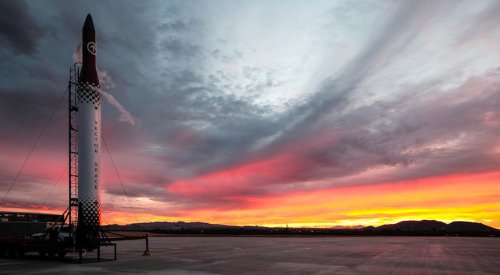Vector Space Systems said Thursday it has won approval to develop a manufacturing facility in Tucson, Arizona.
The company said that county supervisors approved a 25-year lease of land in a business park near the Tucson airport, and the company planned to start construction on the site in the spring.
The company, which is developing a small launch vehicle, also said it successfully test-fired a 5,000-lbf. engine that will be used on its vehicle; that engine features a 3D-printed injector developed in cooperation with NASA. [Vector Space Systems]
More News
A Pegasus rocket successfully launched eight hurricane forecasting microsatellites Thursday. The Pegasus XL rocket was released from its L-1011 aircraft at 8:37 a.m. Eastern Thursday and placed the eight Cyclone Global Navigation Satellite System (CYGNSS) satellites into low Earth orbit 13 minutes later. The CYGNSS satellites will detect GPS signals scattered off the ocean surface to measure wind speeds, aiding hurricane forecasting efforts. The launch, postponed from Monday because of technical issues, was the first flight of a Pegasus XL since the launch of another NASA mission in June 2013. [SpaceNews]
The chairman of the Federal Communications Commission, who has been critical of the satellite industry over spectrum issues, is stepping down. Tom Wheeler announced Thursday that he will resign from the FCC on Jan. 20. Wheeler’s resignation had been expected given the presidential transition, but he had delayed announcing it to the consternation of some Republicans in Congress. Wheeler, who became chairman in 2013, criticized the satellite industry earlier this year for not being willing to share spectrum to support development of 5G terrestrial wireless systems. [SpaceNews]
Pentagon officials say missile defense systems need a new generation of tracking satellites. At a forum this week, officials with the U.S. Air Force and Missile Defense Agency said that while they rely on terrestrial tracking systems now, a space-based layer could fill gaps in coverage. Such a system would augment current satellites in geostationary orbit that provide warning of missile launches but can’t track their trajectories accurately enough to support missile defense systems. [SpaceNews]
The head of NASA’s science mission directorate said he is not concerned about the influence the new administration will have on the agency’s Earth science work. Thomas Zurbuchen said in an interview this week that Earth science has been a part of NASA’s activities since the agency’s inception, and believed it offered value to taxpayers. He added that, unlike the Energy Department, NASA had not been asked to identify scientists who are working on climate change research. [Nature]
A Georgia legislative committee has endorsed legislation supporting development of a spaceport in the state. A state senate committee said Thursday that it supported legislation that would provide liability protections for companies launching from the state, similar to laws in a number of other states. A bill providing that liability protection will be taken up in the state legislature in 2017. The bill is considered vital to plans to develop a commercial launch site in Camden County, Georgia, on the Atlantic coast. [Brunswick (Ga.) News]
A Japanese company is getting into the space resources business. Tokyo-based ispace technologies Inc. announced Friday that it has signed an agreement with the Japanese space agency JAXA to work on a roadmap for lunar resource development. Ispace also handles business operations for Team Hakuto, a competitor in the Google Lunar X Prize. [Wall Street Journal]
The dwarf planet Ceres has large amounts of water ice. Scientists said Thursday that observations of Ceres, the largest object in the main asteroid belt, by NASA’s Dawn spacecraft indicated that up to 30 percent of its mass might be water. Ceres likely has an ice-rich crust, which could explain the shapes of craters on its surface. Scientists also found evidence of patches of water ice on its surface, in permanently shadowed regions of craters near its poles. [Space.com]
For the fifth year in a row, NASA is ranked as the best place to work in the federal government. The agency came out on top among large agencies, well ahead of second-place Commerce Department in the numerical scoring developed by Partnership for Public Service. NASA’s score in the survey, 78.6, was an improvement on the 76.1 it received in the 2015 survey. [Government Executive]
NASA is left not holding the bag after a judge ruled against the government in a memorabilia case. The government sought to take possession of an Apollo 11 lunar sample bag that it mistakenly sold for $995 at auction in 2015, part of property seized by U.S. Marshals from former museum curator Max Ary. A mix-up in paperwork led the marshals to believe the sample bag belonged to Ary rather than being government property. A U.S. District Court judge ruled that the woman who bought the bag was “a good faith purchaser, in a sale conducted according to law,” and thus did nothing wrong that would merit returning the bag to NASA. [collectSPACE]
- Sessions weighs in on NASA transition, astronauts float Doug Cooke for administrator
- Trump adviser sees Pence playing a major role in space policy
- Spanish propulsion startup wants to build Europe’s first reusable rockets
- How Trump Could Wage a War on Scientific Expertise
- Europe commits to the space station and ExoMars as part of $11 billion in commitments to ESA
Share with your friends

(0) Comments
This article comments are currently no :(